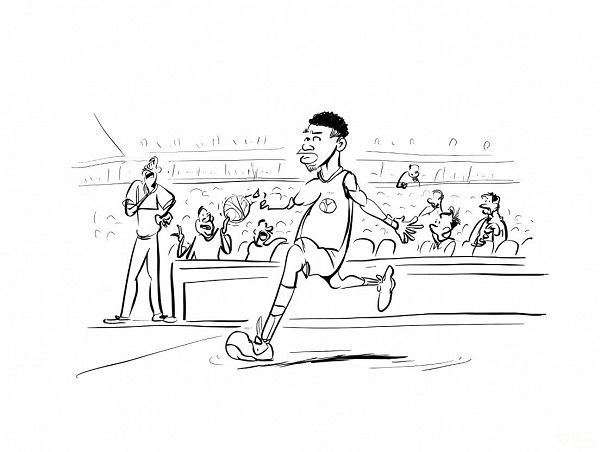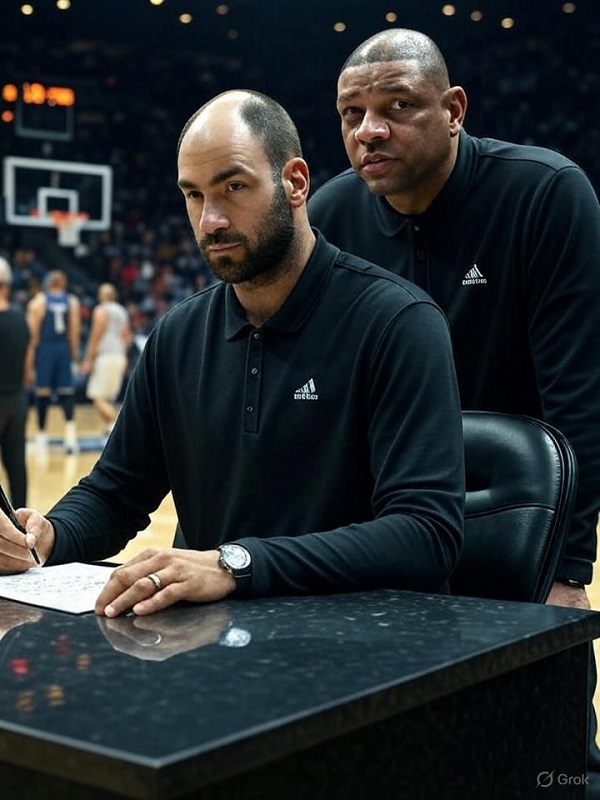Milwaukee Bucks fans are at it again. As the 2024-25 season wrapped up with another frustrating early playoff exit— a first-round flameout against the Pacers after scraping into the postseason as the East’s No. 5 seed at 48-34—the scapegoat du jour is Doc Rivers. Social media is ablaze with calls for his firing, memes about his “clutch-time meltdowns,” and hot takes blaming everything from his rotations to his post-game pressers. But let’s pump the brakes. Doc Rivers isn’t the villain here. He’s a championship-winning coach (2008 with the Celtics, remember?) who’s now saddled with a .548 winning percentage in Milwaukee despite inheriting a roster that’s equal parts superstar talent and glaring mismatches. The real culprit? Giannis Antetokounmpo. Yeah, the two-time MVP, Finals MVP, and perpetual All-NBA freak of nature. His limitations—stubborn refusal to evolve his game, a personality that keeps potential teammates at arm’s length, and a playing style that’s tailor-made for 82-game stat-padding but crumbles under playoff pressure—are the anchors dragging this franchise down. It’s time to stop with the excuses and face the music: Giannis is a regular-season monster who vanishes when the lights get brightest.
Doc Rivers: The Fall Guy for a Flawed Star System
Hired mid-2023-24 after Adrian Griffin’s abrupt firing, Doc Rivers walked into a pressure cooker. The Bucks were 30-13 under Griffin, but whispers of locker-room discord and defensive lapses were already swirling. Rivers steadied the ship somewhat, finishing that season at 13-7 after a rocky 5-6 start in his tenure. Fast-forward to 2024-25: 48 wins, a top-11 offense (115.5 PPG), and a middling defense (113.0 PPG allowed)—hardly the apocalypse. His overall Bucks record? A pedestrian 66-54.
Fans point to Doc’s “poor adjustments” in the playoffs—like last year’s second-round debacle against the Celtics in 2024, where Milwaukee got swept in five after Giannis’ calf injury sidelined him for two games. But even when healthy, Rivers’ teams have overachieved relative to talent. In Boston, he won 56 games with a balanced roster; in Milwaukee, he’s squeezing blood from a stone. As one insider noted ahead of 2025-26, Rivers is “uniquely qualified” to maximise this group’s defence, yet the Bucks’ interior personnel (hello, Giannis and Lopez) hasn’t translated to elite stops because the offence stalls in crunch time—more on that later.
Blame Doc if you want rotation roulette or sideline suits, but he’s not the reason the Bucks are 11-17 in the playoffs since their 2021 title run. That’s on the guy whose name is on the marquee.
Giannis’ Game: All Gas, No Brakes—And No Jumper
Giannis Antetokounmpo is a walking highlight reel: 6’11”, freight-train athleticism, and stats that scream superstar. Career regular-season averages? 23.9 PPG, 9.9 RPG, 4.9 APG on freakish efficiency. In 2024-25, he bumped that to 30.4 PPG and 11.9 RPG, finishing second in scoring. But playoffs? That’s where the mask slips. Career postseason: 27.0 PPG and 12.2 RPG—impressive volume, sure, but on brutal efficiency. His true shooting dips to 56% from 61% in the regular season, and his three-point volume craters (1.5 makes on 4.0 attempts at 38%, vs. 29% career). Teams pack the paint, dare him to shoot, and he obliges with wild drives that yield turnovers or contested bricks.
The real indictment? Clutch time. In his last seven playoff games (spanning 2024-25’s first-round exit), Giannis averaged 29.9 PPG but on laughable 53/25/60 splits—53% FG, 25% from three, 60% FT—and a 56% TS. That’s not elite; that’s inefficient heroism. Critics have roasted him for years: In 2020, he “choked” against the Heat by settling for jumpers instead of attacking; in 2023, Miami’s zone exposed his lack of shooting, forcing 20+ FT attempts per game (he shot 63% from the line). Even in the 2021 Finals, his 50-point closeout was iconic, but it masked a series of inefficient outbursts (e.g., 34 points on 28 shots in Game 4).
At 30, Giannis hasn’t grown. No reliable mid-range, no pull-up game, no off-ball movement. He’s a one-dimensional bulldozer who pads stats in open-floor regular-season romps but gets neutralized when schemes tighten. As one analyst put it, “Giannis is the only severely limited player of that caliber in the NBA,” and opponents exploit it ruthlessly. Doc can’t coach evolution into a guy who’s won two MVPs without bothering to add a jumper. He can’t screen either. Hell, he can’t even understand more advanced plays and dumbs down the entire team.
The Lone Wolf: Why Superstars Ghost the Bucks
Giannis’ personality doesn’t help recruitment. He’s infamously antisocial with rivals—refusing offseason workouts with other NBA players because it “takes off his edge.” In a league where chemistry is king (think Curry-Draymond or LeBron-AD), this “me vs. the world” vibe screams red flag. He doesn’t train with active players, doesn’t build bonds; it’s all business, no buddies. Damian Lillard joined in 2023, sure, but that was a salary-dump necessity, not a dream team-up. Dame’s fit was clunky—pick-and-rolls fizzle because Giannis clogs the lane—and whispers of friction emerged by mid-2025.
Other stars? Crickets. Why join a small-market grind where you’re the sidekick to a ball-dominant alpha who won’t pass out of doubles? Trade rumours swirl around Giannis himself—recent “very real” talks with the front office about his future—but no superstar is lining up for Milwaukee. As one Bucks beat writer noted, even Giannis knows trades happen to “superstars” if the front office falters, yet his isolated style makes building a superteam feel impossible. In an era of player empowerment, who’d choose iso-ball in the Deer District over Hollywood glamour?
Excuses, Excuses: Bucks Fans’ Greatest Hits (And Misses)
Bucks Nation has a PhD in deflection. Let’s run through the classics:
- Coaches Are the Cancer: Budenholzer “couldn’t adjust” in 2023 (fired after a first-round loss). Griffin was “too green” in 2024 (axed after 43 games). Now Doc’s “clueless rotations” and “awful clutch offense” get the boot. Reality? Three coaches in four years, same result: playoff no-shows. The constant? Giannis’ unchanged game.
- Front Office Fiascos: Jon Horst gets roasted for trading Jrue Holiday for Lillard (a net loss in defense and vibes) or not surrounding Giannis with shooters. Fair, but Horst built the 2021 champs. Blaming execs ignores that no GM can fix a star who won’t shoot threes.
- Refs Robbing Us Blind: “The league hates Milwaukee!” cries after every foul call (or non-call) on Giannis’ drives. But his 60% FT in playoffs? That’s on him, not zebras.
- Injuries Are Curses: Giannis’ 2024 calf tear, Middleton’s endless ankles, Lillard’s groin—valid hurdles, but they’ve played 70+ games each in 2024-25. Excuses don’t win series.
- Roster Rejects: “We need shooters!” Sure, but adding Portis and Crowder hasn’t moved the needle because Giannis’ gravity pulls defenders inward, killing spacing.
These aren’t conspiracies; they’re shields against the truth. As Kevin Garnett bluntly said, Doc’s struggles stem from “the players,” not his schemes—every roster can’t play for him, but Giannis’ limitations amplify flaws everywhere.
Time to Trade the Freak? A Reckoning for Milwaukee
The Bucks’ 2021 ring was lightning in a bottle—health, grit, and a perfect storm. Since? Four straight playoff disappointments: ECF loss in 2022, first-rounders in ’23 and ’24, and another quick exit in ’25. Giannis is the common denominator: a stat-sheet stuffer who feasts on regular-season cupcakes (30+ PPG on fast breaks) but wilts when schemed against. His “clutch block” in 2021 was magic; his 2025 closeouts were duds.
Doc Rivers might not be the saviour, but firing him now is just another excuse. The real fix? A hard reset around a star who can actually grow—or trade the one who won’t. Bucks fans, your loyalty is admirable, but denial is deadly. Face it: The Greek Freak’s limitations aren’t fixable by coaching tapes or trades. They’re baked in. Until Milwaukee admits that, the parade dreams stay on hold.
If you’re reading this in Milwaukee, stock up on therapy sessions. Stop sharing his points/assists/rebound numbers. We all know they are rigged for him, the entire team helping him get those numbers and sacrificing their own. Stop shouting “when he gets a jumper…” he never will. Or “wow, what a dribble” in the one time it works out. Giannis can’t shoot. He can’t dribble (tops the leagues in palming and other errors.) He can’t pass, Sengun is 100% correct. Forget about that highlight mid season when it didn’t count. He has no court vision and no basketball IQ. Stop judging him from highlights against easy opponents and re-watch the tougher games. The truth hurts, but it’s the only path forward.
Giannis loves Doc Rivers – here is why and how https://greekinter.net/giannis/2025/05/20/doc-rivers-tenure-with-the-milwaukee-bucks-giannis-loves-him-end-of-story/
What Doc Rivers said to Giannis and Dame in their not so secret meeting https://greekinter.net/giannis/2025/03/23/what-doc-rivers-said-to-dame-and-giannis-in-their-secret-meeting/
Giannis is uncoachable – read the signs https://greekinter.net/giannis/2025/03/19/it-aint-doc-rivers-fault-giannis-is-simply-uncoachable/


